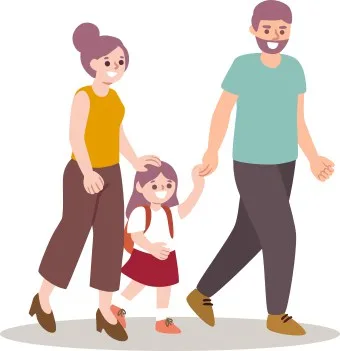The first day of preschool or the first day of daycare is exciting, but it can also be an overwhelming experience for young children.
This article will give you six tips on how to help your child deal with separation anxiety on this important day.

TABLE OF CONTENTS
First Day Of Preschool
So you’ve researched, visited all the preschools in your area, talked to numerous parents, and finally decided on the one preschool for your toddler.
It is time to start preschool.
Your child has been prepped about the first day of school and was sent to bed early.
So, are you excited about the first pre-k drop-off?
If you’re like most parents, you are dreading the first day in preschool or daycare.
This is probably the first time you will be separated from your baby for a long stretch of time.
As much as it’s hard for you, it’s a lot harder for your toddler.
Starting preschool can be exciting but also nerve-wracking.
People may keep telling you stories of how their preschool kids cried for weeks or months before they could settle in the new place
… but kids crying on the first day of nursery school is normal
… screaming and crying are normal
… separation anxiety in preschoolers is normal
… eventually, they will stop, and the child will adapt to the new environment
… You just need to get ready and get used to it.

Experience vs Science
Many well-meaning people, including experienced teachers, will tell you to drop off, say goodbye, and then leave as quickly as possible without looking back.
1st day of preschool can also be chaotic and overwhelming for the teachers.
Understandably, they want less distraction and parents to be out of the way.
Most children will indeed stop crying within five minutes after seeing their parents leave.
This strategy has proven to work in the grownups’ eyes.
But a strategy that seems to work for grownups (because then we can go about our business) is not always the best for our kids.
Besides the appearance of it “working,” many people favor this ripping-off-the-band-aid strategy because it seems to make sense.
We’ve all had that “get it over with” experience.
But this isn’t the right analogy to use in this case.
For starters, the brain works a lot more differently than the skin.
Your child’s brain can think, contemplate, and feel emotions.
The skin cannot.
Treating a person’s brain as if you’re treating their skin is like telling an airplane pilot to fly a plane by just “paddling and keeping balance.” It’s not only naive but also dangerous.
The first day of pre-k can begin without drama.
Sending a 3-year-old to preschool can be a positive experience.
In the next section, we’ll look at tips on how to help your toddler adjust to this big day.
Some of the advice is counter-intuitive or counter-conventional wisdom, but extensive studies by psychologists and researchers back them.
The advance in technology and brain studies has given us much information on child development.
This new knowledge helps us understand child behavior previously misunderstood, dispel old beliefs, and allow us to raise healthier and happier kids.
Here are some tips on how to help ease preschooler separation anxiety on the first day of preschool.
1. Plan to spend lots of time on the first day at the preschool or daycare
You may receive a lot of advice from experienced parents when preparing for this big day for your preschooler.
You may hear that parents shouldn’t linger.
Otherwise, it would be harder for the child to separate, and the child would be less likely to interact with the new people and environment.
So, tip #1 is precisely the opposite of this traditional view.
A child learns about this world by observing and experimenting.
If you were the toddler still trying to figure out this world, when you were brought to an unfamiliar place and the person you trusted most left immediately, what would you think?
Would you think that …
“I’m in good hands now. I should trust these new people like Mommy told me to”, or
“Oh no, Mommy runs off. Is this a bad place? Who are these people”?
Most younger toddlers would panic.
They’re scared of separation, and they’re anxious about what this new environment would entail.
They don’t understand why you’re leaving, why they’re left behind, and what these new people and new places would do to them.
Evolutionarily speaking, being away from her parents was dangerous for a young child.
Separation anxiety is a useful trait built into our genes because it is critical for helpless young kids to stay close to their parents to survive.
That is why the separation distress system in the lower brain is genetically programmed to be hypersensitive.
With the development of the frontal lobes, which isn’t complete until our mid-twenties, adults learn to inhibit this system and bring it under control cognitively.
But your toddler is not there yet.
They’re still years away from having reliable control of their cognition.
So your toddler’s panicking facing such a big transition is normal.
Having a fear of the unknown doesn’t mean she’s weak, spoiled, needy, or clingy.
If your child is crying and fussing during the first drop-off, stay for longer with him.
Most teachers will tell you to leave.
But what if you are a toddler? Do you want to be abandoned when distressed?
Although separation anxiety is a normal part of toddlerhood, it doesn’t mean we ignore it or let it run its course.
When a kid feels rejected or abandoned, the parts activated in his brain are the same parts activated by physical pain.
That means the pain of being rejected resembles physical pain.1,2
Just like we don’t ignore a child when he’s physically hurting, we don’t ignore a child’s emotional pain from separation.
Parents being responsive to their child’s distress has been proven to link to better social-emotional competence and the development of secure attachment.3
Consistent, responsive parenting is also associated with young children’s faster cognitive and social development.4
Not every toddler will suffer from severe separation anxiety.
Given enough prior preparation and maturity, your child may be able to understand what preschool is about and will not cry much.
In this case, confirm with your preschool kid when you will return and do that.
However, younger children or having a more challenging time may require more help.
Do not feel pressured to abandon your child because the preschool teacher says it’s okay.
2. Lots of hugging and holding
When we are distressed, our lower brain triggers the release of the stress hormone cortisol to prepare our body for a fight-or-flight reaction.
To help a child in distress, hugging is one of the most effective ways.
Hugging or holding facilitates the release of oxytocin, a feel-good chemical that can cause the cortisol level to drop.
3. Say goodbye when leaving and point out the time of return
No sneaky disappearance – sneaky disappearance may make the parents feel better because they don’t have to face the child’s devastating cries.
But to the child, being abandoned damages the child’s trust in you.
So don’t just sneak away.
Say goodbye before you leave to build trust.
Some parents develop a goodbye routine to depart slightly easier and more fun (e.g., goodbye song, goodbye handshake, etc.)
Point to the clock and let him know when you will return to pick him up (and mean it!), even if your child doesn’t know how to read the clock yet.
He must know you will return at some point.
4. Pass the holding on to a teacher
Sometimes, parents can’t stay this long.
Sometimes, your toddler may still be upset even though you’ve already stayed for a long time to help her adapt.
If your child still really cannot calm down when you leave, have a sensitive teacher hold her.
Ask the child’s teacher to spend time talking to her and calming her.
Your toddler must not be still crying or highly anxious when the holding ends.
Young children cannot regulate their own emotions effectively.
They may require a lot of external help to do so.5
5. Shorter days at first
Pick up the child early on day one.
Over the next few days, slowly increase the time he stays to ease him into a full-day program.
Even if a child seems okay, it doesn’t mean he is fine inside.
Cortisol has a circadian cycle. It is naturally high in the morning and reduces as the day progresses.
Studies show that young children in daycare have cortisol levels continually rising throughout the day rather than falling despite the lack of detectable distress from the outside.6
A child can be in distress without crying or looking stressed.
His emotion is just hidden or bottled up.
This is particularly common in cultures where the crying of children, especially boys, is highly discouraged.
To make things worse, children who do not appear upset are less likely to get comforted, prolonging the internal dysregulation.
Having a sustained high cortisol level can lead to hypersensitivity of a child’s distress response system and many health issues later in life.
So, even if the child has stopped crying or seems to be doing fine, it is better to have shorter days at first.
6. Always be positive and encouraging
On drop off or pick up, be encouraging and be patient, even when the child may not be on her best behavior.
Help the child feel that going to preschool is a positive experience.
It’s not a place where her normal behavior will be criticized or reprimanded.
Positive life experience in the early years forms an important foundation for a child’s brain development.
Final Thoughts On The Big Day For PreK
Not all of us can afford the time or resources to follow the abovementioned advice on the first day of preschool.
It does not mean, however, that we should ignore the real effects on our children and live in denial.
At the end of the day, we make tradeoffs within our means based on what we know is best. Get all the facts before making a decision.
Knowing you’ve already done your best with what you know and what you can is all that matters, and there is no need for mom guilt.
For some families, preschool is the parent’s first opportunity to be socially judged whether we are apt parents (by teachers, of all people).
They may be pressured to do what other parents do or what the “authority” tells them. Instead, make decisions in the best interest of your child. Be a good role model to them by not caving in under social pressure.
References
- 1.Eisenberger N. The neural bases of social pain: evidence for shared representations with physical pain. Psychosom Med. 2012;74(2):126-135. https://www.ncbi.nlm.nih.gov/pubmed/22286852.
- 2.Eisenberger N. The pain of social disconnection: examining the shared neural underpinnings of physical and social pain. Nat Rev Neurosci. 2012;13(6):421-434. https://www.ncbi.nlm.nih.gov/pubmed/22551663.
- 3.Landry S, Smith K, Swank P, Assel M, Vellet S. Does early responsive parenting have a special importance for children’s development or is consistency across early childhood necessary? Dev Psychol. 2001;37(3):387-403. https://www.ncbi.nlm.nih.gov/pubmed/11370914.
- 4.Denham SA. Maternal Emotional Responsiveness and Toddlers’ Social-Emotional Competence. J Child Psychol & Psychiat. July 1993:715-728. doi:10.1111/j.1469-7610.1993.tb01066.x
- 5.Potegal M, Davidson R. Temper tantrums in young children: 1. Behavioral composition. J Dev Behav Pediatr. 2003;24(3):140-147. https://www.ncbi.nlm.nih.gov/pubmed/12806225.
- 6.Watamura S, Donzella B, Alwin J, Gunnar M. Morning-to-afternoon increases in cortisol concentrations for infants and toddlers at child care: age differences and behavioral correlates. Child Dev. 2003;74(4):1006-1020. https://www.ncbi.nlm.nih.gov/pubmed/12938695.
